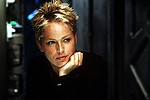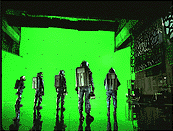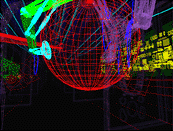
Directed by Barry Levinson
Visual Effects Supervisor: Jeff Okun
VFX Director of Photography: Dave Stump

Directed by Barry Levinson
Visual Effects Supervisor: Jeff Okun
VFX Director of Photography: Dave Stump
SONY PICTURES IMAGEWORKS
GRANT MCCUNE DESIGN
XFX
Review by Todd Vaziri
Dustin Hoffman and Samuel L. Jackson star in the much-delayed SPHERE, the Barry Levinson film that was originally slated for release last fall. SPHERE features a bevy of digital effects provided by Cinesite Hollywood (around 400 shots total), as well as a good amount of miniature work, all used to depict the foreign undersea environment. In addition, Sony Imageworks was brought in at the eleventh hour to provide some of the film's closing effects, as the movie's ending was significantly altered mere weeks before the release. Although the effects work contains a few bright moments, the film's effects, especially revolving around the underwater shots, are subdued and standard.
Some of the SPHERE's earliest effects shots are a series of complicated digital matte paintings, depicting the topside activity. Several ships are scattered on the ocean's surface as part of the team investigating the presence of an alien ship at the bottom of the sea. These shots are pretty cool and very invisible. The seams where the different elements meet cannot be seen.
The first below-water shot is a dissapointing prologue to the rest of the film's effects--the camera, angled up at the surface of the water, follows the descending sub carrying the heroes. A patch of the surface is visible, looking far too bright and odd. Much of the subsequent shots of the sub descending to the habitat are dull and uninspiring. A heavy emphasis on CG animation is visible in these sequences--the sub flies overhead as its propellors leave a trail of bubbles and cavitation. The shot is undoubtedly synthetic. The motion-control-shot models used for these sequences appear much smaller than the scale they are intended to portray, and some CG bubbles appear far too sharp and out of place.
 Visual Effects Produced by:
Visual Effects Produced by:
CINESITE
Visual Effects Supervisor: Carlos Arguello
Full Cinesite Credits
CG Supervisor: Walt Hyneman
Supervisor: Grant McCune


Above left is a frame from the production greenscreen photography of our heroes investigating the mysterious Sphere. At right is a wireframe model, produced by Cinesite, depicting the placement of the various 3D CG elements to be rendered. Below is a still from the final composite. Notice the digital light beams emanating from the actors' flashlights. 
SPHERE images Copyright © 1998 Warner Bros. |
As Hoffman and Sharon Stone venture into the alien craft, they reach the bridge, and are shown what the ship's computer calls an "Unknown Entry Event". In a combination of The Ride sequence and opening shot from CONTACT, and a holodeck scene from "Star Trek: The Next Generation", the environment around Hoffman and Stone dramatically changes as they are placed in the middle of a space journey, with asteroids, nebulae and other space elements circling around them. It is a stunning, visually stimulating sequence, although a bit derivative in style. The best moments of the sequence are times where elements weave between Hoffman and Stone. The sequence closes with the single finest shot of the film, a simplistic series of white stars streaking across the screen against the blackness of space, with the camera rotating quickly. It was so successful (albiet a little out of place, in that the previous shots were so full of highly saturated colors), the filmmakers repeated the shot to close the film.
The title element appears as the heroes discover the Sphere, the shiny, undulating gold ball, a presence that reflects its environment except for the humans surrounding it. The shots of every Sphere sequence is a tremendous success for Cinesite's CG, compositing and, quite significantly, matchmoving departments. The actors were shot entirely within a greenscreen stage, while the surrounding elements, the bay and the Sphere, were synthetic. The camera moves freely around the actors and the Sphere--at no point throughout the entire sequence do the elements slide, jiggle or appear mismatched. Greenscreen matte extractions were clean and unnoticeable. But probably the most successful, invisible part of the sequence is the unbelievably accurate integration of digital light beams emanating from the explorers' flashlights and helmets. Because the actors were shot against a greenscreen, and light beams would not have been visible on stage, Cinesite added the beams digitally. The beams are totally locked to the bulbs, and at no point does this piece of visual effects make itself apparent.
A long jellyfish attack sequence features a combination of real, CG and puppet jellyfish, and the movement and appearance of the CG jellyfish make the creatures quite photorealistic and organic-looking. The lighting and compositing of the sequence is top-notch.
The film concludes with a series of interesting, odd shots, as our heroes rise to the surface in an escape pod, and the Sphere inexplicably rises through the water only to blast itself into space in a dull, anticlimactic blur. Surface shots of the Sphere rising out of the water, while using previously seen elements, appeared too contrasty and sharp.
Include into the mix a generous supply of greenscreen composites, split screens and other invisible effects.
Check out Cinefex 74.
Official Web Site: http://www.sphere-themovie.com

. . VFX HQ Produced by Todd Vaziri . . http://www.vfxhq.com . . e-mail: tvaziri@gmail.com . .
All text Copyright © 1998 Todd Vaziri, unless otherwise noted